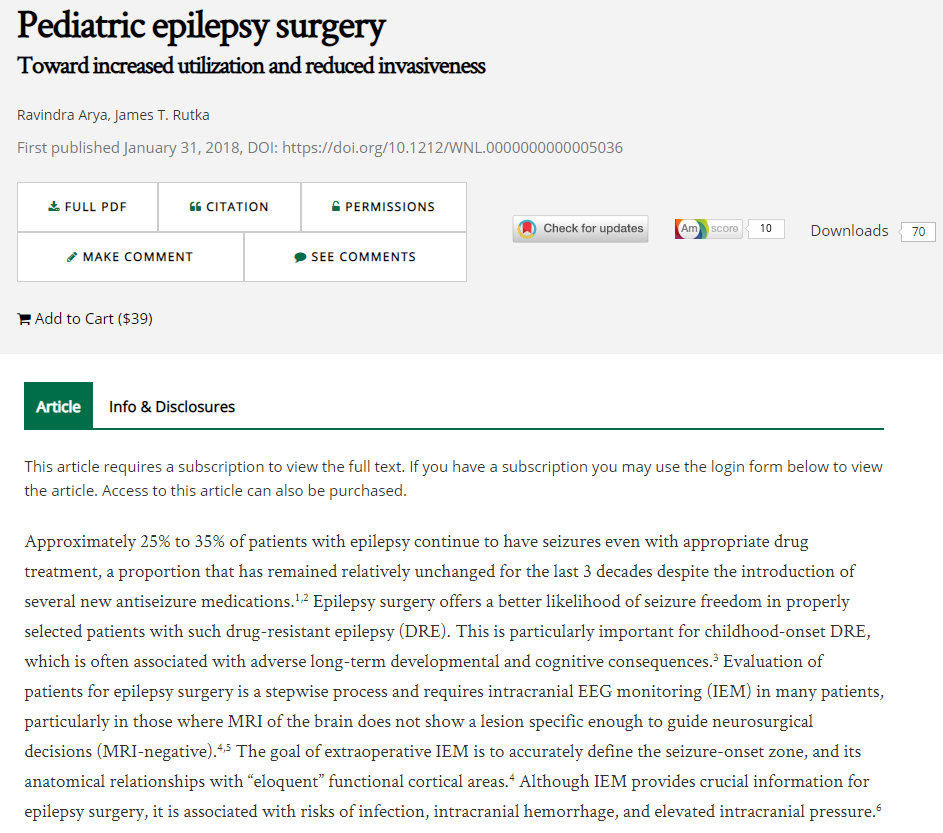Pediatric epilepsy surgery:Toward increased utilization and reduced invasiveness(小儿癫痫手术:致力于提高利用率并减少入侵)
英文摘要:
Approximately 25% to 35% of patients with epilepsy continue to have seizures even with appropriate drug treatment, a proportion that has remained relatively unchanged for the last 3 decades despite the introduction of several new antiseizure medications.Epilepsy surgery offers a better likelihood of seizure freedom in properly selected patients with such drug-resistant epilepsy (DRE). This is particularly important for childhood-onset DRE, which is often associated with adverse long-term developmental and cognitive consequences. Evaluation of patients for epilepsy surgery is a stepwise process and requires intracranial EEG monitoring (IEM) in many patients, particularly in those where MRI of the brain does not show a lesion specific enough to guide neurosurgical decisions (MRI-negative).The goal of extraoperative IEM is to accurately define the seizure-onset zone, and its anatomical relationships with “eloquent” functional cortical areas. Although IEM provides crucial information for epilepsy surgery, it is associated with risks of infection, intracranial hemorrhage, and elevated intracranial pressure. These adverse events are not trivial and have required an additional surgical procedure(s) in up to 3.5% of patients. Over time, recognition of these adverse events, understanding their mechanisms, and improvements in surgical technique have resulted in increased safety and use of IEM. Nevertheless, key questions remain regarding the long-term trends in the utilization of IEM and whether increased use of IEM has resulted in improved safety and efficacy of epilepsy surgery in pediatric DRE.
中文摘要:
即使采用适当的药物治疗,约有25%到35%的癫痫患者仍会发作,尽管引入了几种新的抗癫痫药,但在过去的30年中,这一比例保持相对不变。癫痫手术在适当选择的此类耐药性癫痫(DRE)患者中提供了更大的癫痫发作可能性。这对于儿童期DRE重要,DRE通常与不良的长期发展和认知后果相关。3对患者进行癫痫手术的评估是一个逐步的过程,并且需要对许多患者进行颅内EEG监测(IEM),是对于那些脑部MRI表现出不足以指导神经外科决策的病变(MRI阴性)的患者。4,5术外IEM的目标是准确定义癫痫发作区及其与“雄辩的”功能性皮质区域的解剖关系。4尽管IEM为癫痫手术提供了至关重要的信息,但它与感染,颅内出血和颅内压升高的风险相关。6这些不良事件并非微不足道,并且需要多达3.5%的患者进行额外的外科手术。6随着时间的流逝,对这些不良事件的认识,对它们的机制的了解以及外科技术的改进,已导致IEM的顺利性和使用率提高。然而,关于IEM使用的长期趋势以及IEM的增加使用是否已导致小儿DRE癫痫手术的顺利性和合适性提高,仍然存在关键问题。

论文来源:<https://n.neurology.org/content/90/9/401/tab-article-info>
论文作者之一INC国际神经外科医生集团旗下国际神经外科顾问团(WANG)成员、国际神经外科学院前院长、国际神经外科杂志《Journal of Neurosurgery》主编、加拿大多伦多SickKids病童医院神经外科教授、大外科主任James T. Rutka教授。
James T. Rutka教授曾与名古屋大学的杉田健一郎(Kenichiro Sugita)博士在微血管神经外科领域开展了临床研究,并于1990年在东京骏天大学(Juntendo University)获得了分子免疫学博士后研究奖学金。教授发表了超过500多篇的文章,在临床上的研究方向以颅内肿瘤为主,对胶质瘤、纤维瘤、颅咽管瘤、室管膜瘤具有多年的临床经验,擅长清醒开颅术及显微手术。在较近的临床研究上,教授又将重点集中在了儿童脑瘤和癫痫的外科治疗上,并取得了合适的成果。
其实验室在研究脑肿瘤生长和侵袭的机制方面颇有成就,并在Sunnybrook健康科学中心和多伦多大学生物材料和生物医学工程研究所的合作下,正在设计一种基于纳米颗粒的输送系统,作为治疗胶质瘤的一种新方法。




